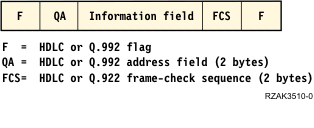This topic provides information about how data is routed through a frame-relay network.
The frame-relay network routes frames through the network by examining the data link connection identifier (DLCI) field and then routing the frame to an outgoing link. The network delivers frames to the remote terminal equipment (TE) in the same sequence as they were provided to the network by the local TE.
At each node within the frame-relay network, the system verifies the frame check sequence (FCS) and checks the frame format and size. If the frame is valid, the system replaces the DLCI and FCS before routing the frame to the next node. If the frame is damaged or otherwise not valid, the system discards it. The network node provides no error recovery.
Frame-relay core services frame format
The following figure shows the basic frame format that is used for frame-relay communications.

The frame-relay core services (FRCS) portion of the frame routes the frame through the frame-relay network. The frame structure is based on the ITU-T Q.922 protocol.
Figure 2 shows the FRCS frame format on the fields within the 2-byte Q.922 address field (QA).
Frame-relay protocol headers
TEs use frame-relay protocol headers to provide routing for frames, to assure data integrity, and to perform recovery when frames are damaged or lost. iSeries™ frame-relay support uses protocol headers that are defined in Frame-Relay Forum IA 3.1.
The IBM®  iSeries system
uses protocol header formats for Systems Network Architecture (SNA) direct,
bridged local area network (LAN), and local management interface (LMI) connections.
The information field of the FRCS frame contains these headers and information
fields (protocol data units or IP packets).
iSeries system
uses protocol header formats for Systems Network Architecture (SNA) direct,
bridged local area network (LAN), and local management interface (LMI) connections.
The information field of the FRCS frame contains these headers and information
fields (protocol data units or IP packets).
The following figures show the protocol header formats.








Table 1 describes the protocol header fields.
| Field | Description | Values and notes |
|---|---|---|
| C | Q.922 (HDLC) control field | |
| PAD | Pad characters | Pad characters (hex 00) are permitted between the control field and the NLPID field. Pad characters are used for boundary alignment. |
| NLPID | Network-level protocol identifier |
|
| PD | Protocol discriminator | LMI frames use hex 08 |
| OUI | Organization-unique identifier |
|
| PID | Protocol identifier | The iSeries system supports the following
formats not using frame check sequence (FCS):
|
| L2 | Layer 2 protocol | For iSeries systems using SNA direct connections,
4C80 is placed in the L2 field Byte 1
Byte 2
|
| L3 | Layer 3 protocol | For iSeries systems using SNA direct connections,
7082 is placed in the L3 field. Byte 1
Byte 2
|
| Information field | iSeries support for SNA direct, frame-relay
connections requires the information field to contain a FID2 protocol data
unit (PDU). Information fields sent over bridged connections may contain FID2 PDUs or IP packets. |
- AC
- Access control
- FC
- Frame control
- DA
- Destination address
- SA
- Source address
- RI
- Routing information
- Lth
- Length
- Type
- Ethernet type
- DSAP
- Destination service access point
- SSAP
- Source service access point
- Ctl
- IEEE 802.2 control field
